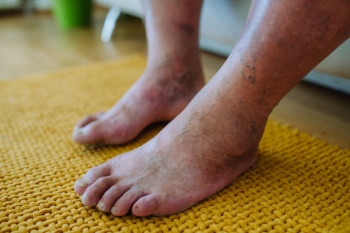Items filtered by date: February 2025
Treat Your Feet to a Medical Pedicure
Are Both Running and Walking Shoes Needed?

Walking shoes and running shoes are designed for different activities, offering unique features to optimize comfort and performance. Walking shoes are generally more flexible, with a cushioned sole that supports the natural rolling motion of the foot during walking. They provide stability and are ideal for low-impact activities. Running shoes have more substantial cushioning, shock absorption, and added support to handle the repetitive high-impact force of running. Running shoes also tend to be lighter and offer more flexibility in the forefoot for better toe-off. While it is possible to use one pair for both activities, having shoes designed specifically for each can enhance comfort, prevent injuries, and improve performance. Therefore, having both walking and running shoes is beneficial for those who regularly engage in both activities. If you have developed foot pain from wearing the wrong shoes while walking or running, it is suggested that you consult a podiatrist who can help you find relief tips, and guide you on the correct shoes to wear for your desired activity.
For more information about walking shoes versus running shoes, consult with one of our podiatrists from Highpoint Foot & Ankle Center. Our practitioners can measure your feet to determine what your needs are and help you find an appropriate pair of footwear.
Foot Health: The Differences between Walking & Running Shoes
There are great ways to stay in shape: running and walking are two great exercises to a healthy lifestyle. It is important to know that running shoes and walking shoes are not interchangeable. There is a key difference on how the feet hit the ground when someone is running or walking. This is why one should be aware that a shoe is designed differently for each activity.
You may be asking yourself what the real differences are between walking and running shoes and the answers may shock you.
Differences
Walking doesn’t involve as much stress or impact on the feet as running does. However, this doesn’t mean that you should be any less prepared. When you’re walking, you land on your heels and have your foot roll forward. This rolling motion requires additional support to the feet.
Flexibility – Walking shoes are designed to have soft, flexible soles. This allows the walker to push off easily with each step.
If you have any questions, please feel free to contact our offices located in Chalfont, Doylestown, and Hatboro, PA . We offer the newest diagnostic and treatment technologies for all your foot care needs.
Diabetic Foot Problems

Diabetic foot care is essential to prevent complications, especially when dealing with wounds. Diabetes can impair circulation and reduce sensation in the feet, making it harder to detect injuries. Small cuts, blisters, or ulcers can go unnoticed and lead to serious infections. Symptoms of a diabetic foot wound include redness, swelling, warmth, or even pus surrounding the affected area, often accompanied by pain or discomfort. In some cases, you may not feel any pain due to nerve damage. It is important to keep the wound clean and dry. For severe wounds, you might need antibiotics or a specialized wound care regimen. A podiatrist can help by thoroughly assessing the wound, providing the right treatments, and monitoring for infection or further complications. This type of doctor may also recommend custom footwear to reduce pressure on vulnerable areas. If you have diabetes and notice any foot wounds, it is suggested that you schedule an appointment with a podiatrist to promote heatling and prevent further issues.
Diabetic foot care is important in preventing foot ailments such as ulcers. If you are suffering from diabetes or have any other concerns about your feet, contact one of our podiatrists from Highpoint Foot & Ankle Center. Our practitioners can provide the care you need to keep you pain-free and on your feet.
Diabetic Foot Care
Diabetes affects millions of people every year. The condition can damage blood vessels in many parts of the body, especially the feet. Because of this, taking care of your feet is essential if you have diabetes, and having a podiatrist help monitor your foot health is highly recommended.
The Importance of Caring for Your Feet
- Routinely inspect your feet for bruises or sores.
- Wear socks that fit your feet comfortably.
- Wear comfortable shoes that provide adequate support.
Patients with diabetes should have their doctor monitor their blood levels, as blood sugar levels play such a huge role in diabetic care. Monitoring these levels on a regular basis is highly advised.
It is always best to inform your healthcare professional of any concerns you may have regarding your feet, especially for diabetic patients. Early treatment and routine foot examinations are keys to maintaining proper health, especially because severe complications can arise if proper treatment is not applied.
If you have any questions please feel free to contact our offices located in Chalfont, Doylestown, and Hatboro, PA . We offer the newest diagnostic and treatment technologies for all your foot and ankle needs.
Sports Injuries That Affect the Feet

Sports injuries that impact the feet are common, especially for active individuals, and can range from mild to severe. The Achilles tendon, which connects the calf muscle to the heel bone, is prone to injury, often through overuse or sudden movements. Symptoms of an Achilles tendon injury include sharp pain, swelling, and difficulty walking or standing on tiptoe. Sprained ankles are also frequent in sports. This occurs when the ligaments surrounding the ankle stretch or tear, often due to a twisted or rolled ankle. Symptoms include pain, swelling, bruising, and limited mobility. In more severe cases, a broken ankle can occur, causing intense pain, bruising, and the inability to bear weight on the foot. Treatment for these injuries typically includes rest along with pain relief and targeted exercises. In some cases, surgery may be needed. A podiatrist can help diagnose and treat sports injuries, offering personalized care for optimal recovery. If you are experiencing any of these conditions, it is suggested that you schedule an appointment with a podiatrist.
Ankle and foot injuries are common among athletes and in many sports. They can be caused by several problems and may be potentially serious. If you are feeling pain or think you were injured in a sporting event or when exercising, consult with one of our podiatrists from Highpoint Foot & Ankle Center. Our practitioners will assess your condition and provide you with quality foot and ankle treatment.
Common Injuries
The most common injuries that occur in sporting activities include:
- Achilles Tendonitis
- Achilles Tendon Rupture
- Ankle Sprains
- Broken Foot
- Plantar Fasciitis
- Stress Fractures
- Turf Toe
Symptoms
Symptoms vary depending upon the injury and in some cases, there may be no symptoms at all. However, in most cases, some form of symptom is experienced. Pain, aching, burning, bruising, tenderness, tightness or stiffness, sensation loss, difficulty moving, and swelling are the most common symptoms.
Treatment
Just as symptoms vary depending upon the injury, so do treatment options. A common treatment method is known as the RICE method. This method involves rest, applying ice, compression and elevating the afflicted foot or ankle. If the injury appears to be more serious, surgery might be required, such as arthroscopic or reconstructive surgery. Lastly, rehabilitation or therapy might be needed to gain full functionality in the afflicted area. Any discomfort experienced by an athlete must be evaluated by a licensed, reputable medical professional.
If you have any questions, please feel free to contact our offices located in Chalfont, Doylestown, and Hatboro, PA . We offer the newest diagnostic and treatment technologies for all your foot care needs.

